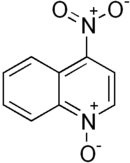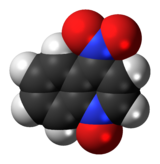51:
309:
196:
510:
42:
614:
706:
DNA damage by 4NQO is a potent model. 4NQO induces DNA lesions usually corrected by nucleotide excision repair. 4NQO’s four electron reduction product, 4-hydroxyaminoquinoline 1-oxide (4HAQO), is believed to be a carcinogenic metabolite of 4NQO. When 4NQO is metabolized to its electrophilic reactant,
714:
Yeast species have been used to map polymorphic regions in response to 4NQO, identifying the polymorphic transcription factor Yrr1. Yrr1 confers 4NQO resistance to wild-type S. cerevisiae yeast, binding upstream from core genes well-known to regulation drug response. Yrr1 shifts cellular response in
710:
The stable quinolone monoadducts oxidize to form 8-hydroxydeoxyguanosine (8OHdG), which, if left unrepaired, lead to transversions of guanines to thymines, which are nucleotides in DNA. Despite the direct mutagenic properties of 4HAQO, it is less toxic than 4NQO, indicating that metabolism of 4NQO
693:
N. 4NQO may naturally occur in the environment but is typically manufactured for research purposes. 4NQO is known to mimic the biological effects of ultraviolet light on various organisms. Both 4NQO and its reduced metabolite 4-hydroxyaminoquinoline 1-oxide (4HAQO) bind covalently to cellular
697:
4NQO has been shown to trap topoisomerase I cleavage complexes. It may also induce DNA damage through the production of reactive oxygen species thought to arise from enzymatic reduction of its nitro group, although its exact mechanism is unknown. 4NQO’s reactive oxygen species may serve as a
518:
490:
746:
LaVoie, Edmond J.; Adams, Elisabeth Ann; Shigematsu, Akemi; Hoffman, Dietrich (September 1983). "On the metabolism of quinoline and isoquinoline: possible molecular basis for differences in biological activities".
698:
byproduct of DNA damage or signaling molecule from damage. In response to damage from 4NQO, cells attempt to repair and initiate a transcriptional response to detoxify the cell from 4NQO and its metabolites.
685:
4-nitroquinoline 1-oxide (4NQO) is a quinoline, a carcinogenic and mutagenic chemical. Quinolines, like 4NQO, possess a heterocyclic aromatic structure and the same basic chemical formula of C
782:
Ikenaga, Mituo; Ichikawa-Ryo, Haruko; Kondo, Sohei (1975). "The major cause of inactivation and mutation by 4-Nitroquinoline 1-Oxide in
Escherichia coli: Excisable 4NQO-purine adducts".
627:
715:
resistance to 4NQO and rates of respiration. In a recent study in yeast, 4NQO was shown to affect chromatin remodelling, cell division and DNA damage repair pathways.
358:
113:
1044:"New Insights into the Pleiotropic Drug Resistance Network from Genome-Wide Characterization of the YRR1 Transcription Factor Regulation System"
958:
Gallagher, Jennifer E. G.; Zheng, Wei; Rong, Xiaoqing; Miranda, Noraliz; Lin, Zhixiang; Dunn, Barbara; Zhao, Hongyu; Snyder, Michael P. (2014).
323:
707:
selyl-4HAQO, it reacts with DNA to form stable quinolone monoadducts considered responsible for its mutagenicity and genotoxicity.
912:
Arima, Yaeno; Nishigori, Chikako; Takeuchi, Toru; Oka, Shigenori; Morimoto, Kanehisa; Utani, Atsushi; Miyachi, Yoshiki (2006).
471:
1090:
Ogbede, J.U., Giaever, G. & Nislow, C. A genome-wide portrait of pervasive drug contaminants. Sci Rep 11, 12487 (2021).
817:
Tada, Mitsuhiko; Tada, Mariko (1975). "Seryl-tRNA synthetase and activation of the carcinogen 4-nitroquinoline 1-oxide".
634:
556:
546:
266:
509:
287:
674:
1042:
Le Crom, Stéphane; Devaux, Frédéric; Marc, Philippe; Zhang, Xiaoting; Moye-Rowley, W. Scott; Jacq, Claude (2002).
203:
1124:
1109:
590:
1007:
Fry, Rebecca C.; Begley, Thomas J.; Samson, Leona D. (2005). "Genome-Wide
Responses to DNA-Damaging Agents".
914:"4-Nitroquinoline 1-Oxide Forms 8-Hydroxydeoxyguanosine in Human Fibroblasts through Reactive Oxygen Species"
564:
191:
50:
153:
1119:
532:
502:
63:
1114:
826:
732:
1129:
870:"4-nitroquinoline-1-oxide induces the formation of cellular topoisomerase I-DNA cleavage complexes"
304:
79:
850:
1073:
1024:
989:
935:
891:
842:
799:
764:
560:
960:"Divergence in a master variator generates distinct phenotypes and transcriptional responses"
1063:
1055:
1016:
979:
971:
925:
881:
834:
791:
756:
658:
454:
381:
28:
1020:
275:
173:
308:
195:
830:
133:
89:
17:
984:
959:
654:
605:
552:
1068:
1043:
1103:
795:
443:
433:
184:
1059:
572:
854:
670:
886:
869:
485:
DANGER: CANCER RISK, causes blood, liver, and thyroid injury; causes DNA adducts
255:
579:
760:
662:
415:
164:
1091:
930:
913:
650:
1077:
1028:
993:
975:
939:
895:
41:
768:
846:
803:
242:
204:
27:"Nqo" redirects here. For the language with the ISO 639 code nqo, see
838:
711:
produces other reactive chemicals such as anion radical metabolites.
666:
144:
604:
Except where otherwise noted, data are given for materials in their
230:
124:
112:
102:
568:
538:
221:
332:
InChI=1S/C9H6N2O3/c12-10-6-5-9(11(13)14)7-3-1-2-4-8(7)10/h1-6H
342:
InChI=1/C9H6N2O3/c12-10-6-5-9(11(13)14)7-3-1-2-4-8(7)10/h1-6H
292:
448:
237 to 243 °C (459 to 469 °F; 510 to 516 K)
622:
438:
26 to 28 °C (79 to 82 °F; 299 to 301 K)
649:(also known as 4-NQO, 4NQO, 4Nqo, NQO and NQNO) is a
665:, and procedures in the prevention and treatment of
694:macromolecules such as nucleic acids and proteins.
657:compound used in the assessment of the efficacy of
254:
88:
953:
951:
949:
907:
905:
673:. It induces DNA lesions usually corrected by
8:
1092:https://doi.org/10.1038/s41598-021-91792-1
307:
194:
172:
33:
1067:
983:
929:
885:
274:
724:
363:
328:
303:
1021:10.1146/annurev.micro.59.031805.133658
598:400 °C (752 °F; 673 K)
584:101 °C (214 °F; 374 K)
185:
335:Key: YHQDZJICGQWFHK-UHFFFAOYSA-N
152:
132:
7:
345:Key: YHQDZJICGQWFHK-UHFFFAOYAP
245:
229:
25:
612:
508:
428:yellow-brown crystals or powder
399:
393:
49:
40:
1060:10.1128/MCB.22.8.2642-2649.2002
608:(at 25 °C , 100 kPa).
1048:Molecular and Cellular Biology
472:Occupational safety and health
405:
387:
1:
1009:Annual Review of Microbiology
887:10.1158/0008-5472.CAN-05-4471
796:10.1016/0022-2836(75)90233-8
784:Journal of Molecular Biology
733:"Quinoline (Benzopyridine)"
1146:
675:nucleotide excision repair
420:190.16 g/mol
26:
602:
489:
469:
464:
374:
354:
319:
72:
62:
57:
48:
39:
35:4-Nitroquinoline 1-oxide
647:4-Nitroquinoline 1-oxide
547:Precautionary statements
67:4-Nitroquinoline 1-oxide
18:4-nitroquinoline 1-oxide
964:Genes & Development
761:10.1093/carcin/4.9.1169
976:10.1101/gad.228940.113
918:Toxicological Sciences
931:10.1093/toxsci/kfj161
366:(=O)c2c1c(cccc1)()cc2
868:Miao, Z.H. (2006).
831:1975Natur.255..510T
455:Solubility in water
36:
635:Infobox references
34:
653:derivative and a
643:Chemical compound
641:
640:
533:Hazard statements
288:CompTox Dashboard
114:Interactive image
16:(Redirected from
1137:
1094:
1088:
1082:
1081:
1071:
1039:
1033:
1032:
1004:
998:
997:
987:
955:
944:
943:
933:
909:
900:
899:
889:
865:
859:
858:
839:10.1038/255510a0
814:
808:
807:
779:
773:
772:
743:
737:
736:
729:
625:
619:
616:
615:
574:
570:
566:
562:
558:
554:
540:
512:
407:
401:
395:
389:
382:Chemical formula
312:
311:
296:
294:
278:
258:
247:
233:
206:
198:
187:
176:
156:
136:
116:
92:
53:
44:
37:
21:
1145:
1144:
1140:
1139:
1138:
1136:
1135:
1134:
1125:Nitro compounds
1110:Cancer research
1100:
1099:
1098:
1097:
1089:
1085:
1041:
1040:
1036:
1006:
1005:
1001:
957:
956:
947:
911:
910:
903:
867:
866:
862:
825:(5508): 510–2.
816:
815:
811:
781:
780:
776:
745:
744:
740:
731:
730:
726:
721:
704:
692:
688:
683:
644:
637:
632:
631:
630: ?)
621:
617:
613:
609:
595:
592:
549:
535:
521:
505:
482:
457:
410:
404:
398:
392:
384:
370:
367:
362:
361:
350:
347:
346:
343:
337:
336:
333:
327:
326:
315:
297:
290:
281:
261:
248:
236:
216:
179:
159:
139:
119:
106:
95:
82:
68:
32:
23:
22:
15:
12:
11:
5:
1143:
1141:
1133:
1132:
1127:
1122:
1117:
1112:
1102:
1101:
1096:
1095:
1083:
1034:
999:
945:
901:
880:(13): 6540–5.
860:
809:
774:
755:(9): 1169–73.
749:Carcinogenesis
738:
723:
722:
720:
717:
703:
700:
690:
686:
682:
679:
642:
639:
638:
633:
611:
610:
606:standard state
603:
600:
599:
596:
589:
586:
585:
582:
576:
575:
550:
545:
542:
541:
536:
531:
528:
527:
522:
517:
514:
513:
506:
501:
498:
497:
487:
486:
483:
480:
477:
476:
467:
466:
462:
461:
458:
453:
450:
449:
446:
440:
439:
436:
430:
429:
426:
422:
421:
418:
412:
411:
408:
402:
396:
390:
385:
380:
377:
376:
372:
371:
369:
368:
365:
357:
356:
355:
352:
351:
349:
348:
344:
341:
340:
338:
334:
331:
330:
322:
321:
320:
317:
316:
314:
313:
300:
298:
286:
283:
282:
280:
279:
271:
269:
263:
262:
260:
259:
251:
249:
241:
238:
237:
235:
234:
226:
224:
218:
217:
215:
214:
210:
208:
200:
199:
189:
181:
180:
178:
177:
169:
167:
161:
160:
158:
157:
149:
147:
141:
140:
138:
137:
129:
127:
121:
120:
118:
117:
109:
107:
100:
97:
96:
94:
93:
85:
83:
78:
75:
74:
70:
69:
66:
60:
59:
55:
54:
46:
45:
24:
14:
13:
10:
9:
6:
4:
3:
2:
1142:
1131:
1128:
1126:
1123:
1121:
1118:
1116:
1113:
1111:
1108:
1107:
1105:
1093:
1087:
1084:
1079:
1075:
1070:
1065:
1061:
1057:
1054:(8): 2642–9.
1053:
1049:
1045:
1038:
1035:
1030:
1026:
1022:
1018:
1014:
1010:
1003:
1000:
995:
991:
986:
981:
977:
973:
970:(4): 409–21.
969:
965:
961:
954:
952:
950:
946:
941:
937:
932:
927:
924:(2): 382–92.
923:
919:
915:
908:
906:
902:
897:
893:
888:
883:
879:
875:
871:
864:
861:
856:
852:
848:
844:
840:
836:
832:
828:
824:
820:
813:
810:
805:
801:
797:
793:
790:(2): 341–56.
789:
785:
778:
775:
770:
766:
762:
758:
754:
750:
742:
739:
734:
728:
725:
718:
716:
712:
708:
701:
699:
695:
680:
678:
676:
672:
671:animal models
668:
664:
660:
656:
652:
648:
636:
629:
624:
607:
601:
597:
594:
588:
587:
583:
581:
578:
577:
551:
548:
544:
543:
537:
534:
530:
529:
526:
523:
520:
516:
515:
511:
507:
504:
500:
499:
495:
493:
488:
484:
479:
478:
474:
473:
468:
463:
459:
456:
452:
451:
447:
445:
444:Boiling point
442:
441:
437:
435:
434:Melting point
432:
431:
427:
424:
423:
419:
417:
414:
413:
386:
383:
379:
378:
373:
364:
360:
353:
339:
329:
325:
318:
310:
306:
305:DTXSID5025780
302:
301:
299:
289:
285:
284:
277:
273:
272:
270:
268:
265:
264:
257:
253:
252:
250:
244:
240:
239:
232:
228:
227:
225:
223:
220:
219:
212:
211:
209:
207:
202:
201:
197:
193:
190:
188:
186:ECHA InfoCard
183:
182:
175:
171:
170:
168:
166:
163:
162:
155:
151:
150:
148:
146:
143:
142:
135:
131:
130:
128:
126:
123:
122:
115:
111:
110:
108:
104:
99:
98:
91:
87:
86:
84:
81:
77:
76:
71:
65:
61:
56:
52:
47:
43:
38:
30:
29:N'Ko language
19:
1120:Amine oxides
1086:
1051:
1047:
1037:
1012:
1008:
1002:
967:
963:
921:
917:
877:
873:
863:
822:
818:
812:
787:
783:
777:
752:
748:
741:
727:
713:
709:
705:
696:
684:
646:
645:
591:Autoignition
524:
491:
481:Main hazards
470:
154:ChEMBL127655
73:Identifiers
1115:Carcinogens
655:tumorigenic
593:temperature
580:Flash point
519:Signal word
475:(OHS/OSH):
425:Appearance
375:Properties
192:100.000.256
134:CHEBI:16907
1130:Quinolines
1104:Categories
1015:: 357–77.
874:Cancer Res
719:References
503:Pictograms
416:Molar mass
276:X5081510EV
165:ChemSpider
101:3D model (
80:CAS Number
64:IUPAC name
702:Technical
651:quinoline
565:P308+P313
494:labelling
460:slightly
213:200-281-1
205:EC Number
1078:11909958
1029:16153173
994:24532717
940:16547075
896:16818625
465:Hazards
985:3937518
855:4151802
827:Bibcode
769:6883639
681:General
628:what is
626: (
243:PubChem
90:56-57-5
1076:
1069:133742
1066:
1027:
992:
982:
938:
894:
853:
847:166317
845:
819:Nature
804:806692
802:
767:
667:cancer
623:verify
620:
525:Danger
359:SMILES
231:C03474
145:ChEMBL
58:Names
851:S2CID
663:drugs
659:diets
324:InChI
125:ChEBI
103:JSmol
1074:PMID
1025:PMID
990:PMID
936:PMID
892:PMID
843:PMID
800:PMID
765:PMID
573:P501
569:P405
561:P281
557:P202
553:P201
539:H350
267:UNII
256:5955
222:KEGG
174:5740
1064:PMC
1056:doi
1017:doi
980:PMC
972:doi
926:doi
882:doi
835:doi
823:255
792:doi
757:doi
669:in
492:GHS
293:EPA
246:CID
1106::
1072:.
1062:.
1052:22
1050:.
1046:.
1023:.
1013:59
1011:.
988:.
978:.
968:28
966:.
962:.
948:^
934:.
922:91
920:.
916:.
904:^
890:.
878:66
876:.
872:.
849:.
841:.
833:.
821:.
798:.
788:92
786:.
763:.
751:.
677:.
661:,
571:,
567:,
563:,
559:,
555:,
496::
1080:.
1058::
1031:.
1019::
996:.
974::
942:.
928::
898:.
884::
857:.
837::
829::
806:.
794::
771:.
759::
753:4
735:.
691:7
689:H
687:9
618:Y
409:3
406:O
403:2
400:N
397:6
394:H
391:9
388:C
295:)
291:(
105:)
31:.
20:)
Text is available under the Creative Commons Attribution-ShareAlike License. Additional terms may apply.

